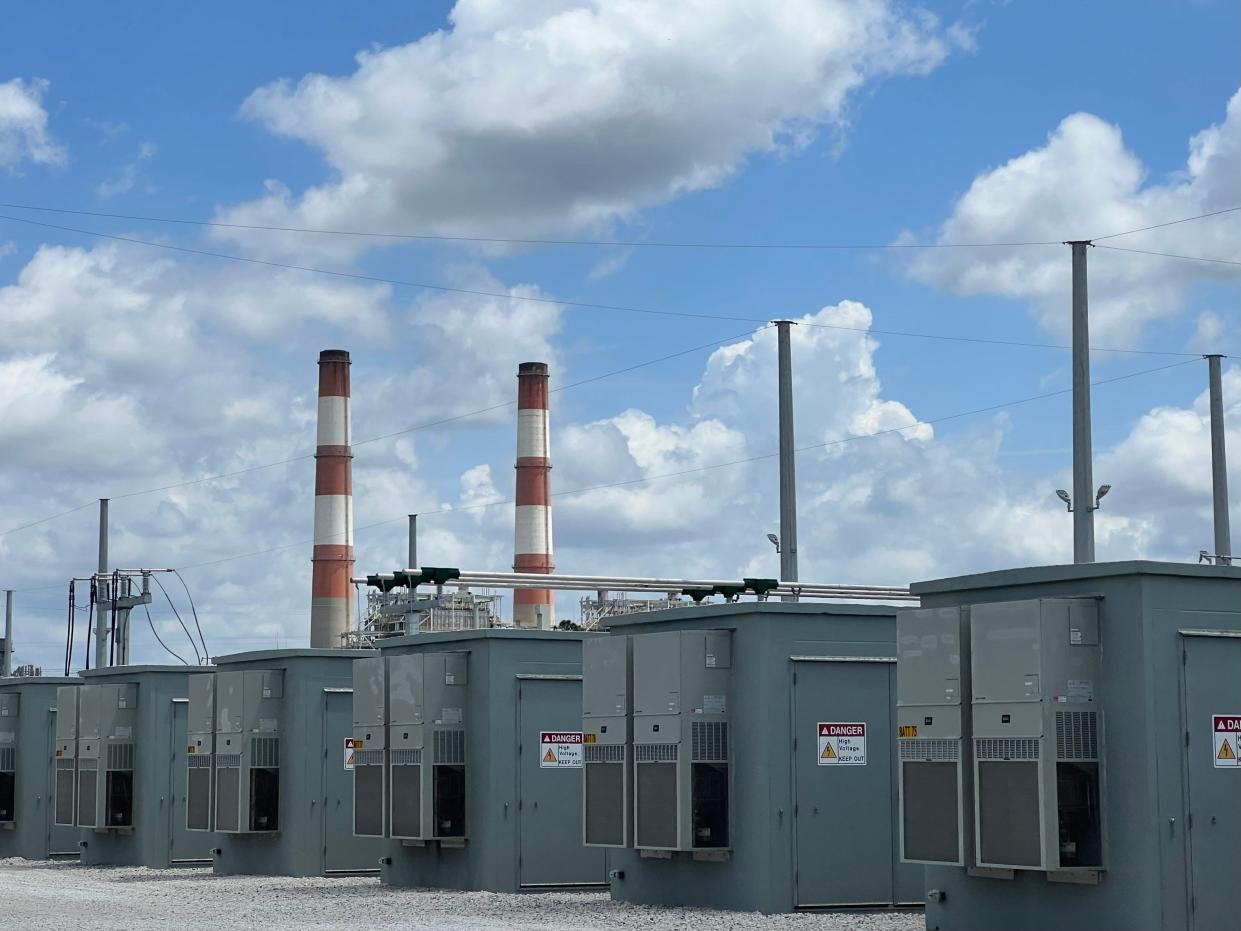Battery storage 'necessary component' to electric utilities' solar power expansion

PARRISH A key to the future of Florida’s electric grid is a device that could be confused for a computer server.
This apparatus is actually a battery module. By themselves, each of the components is as powerful as 2,000 iPhone batteries. But together, as a collection of tens of thousands of modules, they make up what is the world’s largest solar battery storage facility owned by the state’s largest utility, Florida Power & Light.
FPL's Manatee Energy Storage Center is a cutting-edge solar energy technology in an evolving pastoral setting in fast-growing Southwest Florida.
At night or when there is thick cloud cover overhead, energy from the sun captured by the utility's nearby solar panel field can be stored for later use, further reducing the need to rely on fossil fuels and allowing excess renewable energy generated not to go to waste.
More: FPL blows up its last coal-fired power plant; announces plans for its newest solar center
More: Solar advocates push for last-minute changes to net metering bills
More: Why FPL's 'clean' power plants are ranked in report among top carbon producers
Battery storage can fill electric solar gap on cloudy days, at night
Much like a rooftop solar contractor might advise a homeowner to install a battery pack in tandem with their solar system, battery storage is becoming an integral piece of large-scale renewable energy investments.
“I think it’s safe to say that storage is a necessary component as we evolve to more intermittent resources,” said Bryan Jacob, the solar program director for the nonprofit Southern Alliance for Clean Energy.
Battery storage can help bridge the gap between energy resources at the times of day when solar power would come online and offline, Jacob said, or it can serve as the boost needed during spikes in usage, such as when people return home after work.
When these utility-scale solar investments were first being made, “curtailment of solar wasn’t a significant issue yet,” Jacobs said, referring to the process where renewable energy output is reduced from its full potential due to supply-demand needs.
“So now you can absorb excess generation of what would be happening without having to curtail it,” he said.
FPL has more than 500 megawatts of solar power storage, the bulk of it coming from the 409-megawatt Manatee Solar Energy Center in Parrish. Looking 10 years into the future, Juno Beach-based FPL hopes to increase its battery capacity seven-fold by adding another 3,200 megawatts of storage.
“You don’t need as many batteries (as solar plants) because they don’t make new energy, they just store it for later,” Silver said. “Long-term, I think we're going to start to see there's going to be value for batteries helping to meet those afternoon peaks and early morning peaks as we get more and more solar on the system.”
FPL solar battery located in rural town that is seeing population growth
The Parrish facility, which started operations in December, is situated on 40 acres off of State Road 62 in unincorporated Manatee County, where single-family home developments are slowly taking over farmland as Florida charges onward with its rapid growth, in turn adding more consumers onto the grid.

About 400 battery modules, each weighing more than 200 pounds and manufactured by Samsung, are carefully stacked into each of the 132 large metal containers on the site. Outside of each container is a warning: “DANGER. Lithium-ion batteries. Fire and Explosion Risk.”
Each container can store about 7 megawatts, said Marcos Quintana, regional manager for FPL. This storage facility can power 329,000 homes for two hours.
This collection of modules stores energy that comes mostly from the solar power plant, which sits about a half-mile away as the crow flies.
“If in a pinch we need to charge fast and solar is not available, it is technically capable of charging from the grid,” said Matt Silver, project director for FPL development. “But obviously, we want to charge from the solar as much as possible.”
Location of FPL battery speaks to utility's past, present and future
In the background of the solar panels and storage facility is one of FPL’s natural gas power plants, where two 1970s era red-and-white striped smokestacks that tell this half century-old story of Florida’s past and future from fossil fuels to renewable energy.
These smokestacks were set to be decommissioned with the arrival of the solar battery facility, but now they will only be used if high electricity usage in wintertime necessitates it, part of FPL's effort to prepare for extreme winter weather.
The 74.5-megawatt solar power plant, connected to the storage facility by buried cables, started operation in 2016 and is made up of more than 340,000 panels. A herd of cattle roam just outside the gate, while inside, wild hog traps help lure the notoriously destructive species from the expensive equipment.
FPL has 30 megawatts of solar storage on two of its other solar sites in Suwannee and Columbia counties, and the utility has a number of smaller-scale pilot projects while exploring electric vehicle charging stations. Florida’s other major electric utilities, namely Tampa Electric Co. and Duke Energy, are also making investments in battery storage.
“They’re really just another tool in the toolkit,” Silver said. “Everybody’s always looking for the silver bullet or the magic wand that we’ll wave and that’ll solve all your energy needs. But like anything else in life, it’s probably going to be a variety of things that add up cumulatively to solve our energy needs.”
Hannah Morse covers consumer issues for The Palm Beach Post. Drop a line at hmorse@pbpost.com, call 561-820-4833 or follow her on Twitter @mannahhorse.
This article originally appeared on Palm Beach Post: Florida Power & Light looking to boost solar battery storage sevenfold

